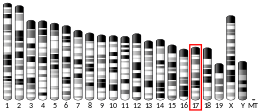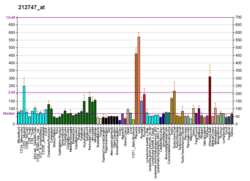ANKS1A
Ankyrin repeat and SAM domain-containing protein 1A (ANKS1A), also known as ODIN, is a protein that in humans is encoded by the ANKS1A gene on chromosome 6.[5][6]
It is ubiquitously expressed in many tissues and cell types.[7] ODIN is known to regulate the epidermal growth factor receptor (EGFR) and EphA receptor signaling pathways.[8] As a Src family kinase target, ODIN has been implicated in the development of cancer.[9] The ANKS1A gene also contains one of 27 SNPs associated with increased risk of coronary artery disease.[10]
Structure
Gene
The ANKS1A gene resides on chromosome 6 at the band 6p21.31 and includes 29 exons.[6] This gene produces 2 isoforms through alternative splicing.[11]
Protein
ODIN is a member of the ankyrin repeat and sterile alpha motif domain-containing (ANKS) family and contains 6 ankyrin repeats, 1 phosphotyrosine binding (PTD) domain, and 2 tandem sterile alpha motif (SAM) domains.[11][12] The first SAM domain binds to the SAM domain of the EphA2 receptor by adopting a mid-loop/end-helix conformation and may regulate EphA2 endocytosis.[12][13]
Function
ODIN is widely expressed in tissues including heart, brain, placenta, lung, liver, skeletal muscle, kidney and pancreas.[14] ODIN has been identified as one of the tyrosine phosphorylated proteins induced by activating epidermal growth factor or platelet-derived growth factor receptor tyrosine kinases.[14] ODIN is involved in negative regulation of the EGFR signaling pathway.[8] It is reported that ODIN level is correlated with the degree of increased EGF-induced EGFR trafficking to recycle endosomes and recycle back to the cell surface, suggesting a role in EGFR recycling.[15] Furthermore, ODIN serves as a key adaptor protein regulating the EphA receptor signaling pathway, which is critical for regulating EphA8-mediated cell migration and neurite outgrowth.[16][17] It has been demonstrated that deletion of the phosphotyrosine binding domain in ODIN will lead to an immaturely developed subcommissural organ (SCO) with a severe midbrain hydrocephalic phenotype, which means ODIN also plays a role in the proper development of the SCO and in ependymal cells in the cerebral aqueduct.[18]
Clinical significance
As a novel target of Src family kinases, which are implicated in the development of some colorectal cancers, ODIN may be involved in cancer cell signaling mechanisms.[19] In a study, 64 colorectal cancer cell lines were tested for their expression of Lck. Mass spectrometric analyses of Lck-purified proteins subsequently identified several proteins readily known as SFK kinase substrates, including cortactin, Tom1L1 (SRCASM), GIT1, vimentin and AFAP1L2 (XB130). Additional proteins previously reported as substrates of other tyrosine kinases were also detected, including ODIN. ODIN was further analyzed and found to contain substantially less pY upon inhibition of SFK activity in SW620 cells, indicating that it is a formerly unknown SFK target in colorectal carcinoma cells.[19] Furthermore, it has been found that ODIN regulates COPII-mediated anterograde transport of receptor tyrosine kinases, which is a critical mechanism in the process of tumor genesis.[20]
Clinical marker
A multi-locus genetic risk score study based on a combination of 27 loci, including the ANKS1A gene, identified individuals at increased risk for both incident and recurrent coronary artery disease events, as well as an enhanced clinical benefit from statin therapy. The study was based on a community cohort study (the Malmo Diet and Cancer study) and four additional randomized controlled trials of primary prevention cohorts (JUPITER and ASCOT) and secondary prevention cohorts (CARE and PROVE IT-TIMI 22).[10]
References
- GRCh38: Ensembl release 89: ENSG00000064999 - Ensembl, May 2017
- GRCm38: Ensembl release 89: ENSMUSG00000024219 - Ensembl, May 2017
- "Human PubMed Reference:". National Center for Biotechnology Information, U.S. National Library of Medicine.
- "Mouse PubMed Reference:". National Center for Biotechnology Information, U.S. National Library of Medicine.
- Nagase T, Seki N, Ishikawa K, Ohira M, Kawarabayasi Y, Ohara O, Tanaka A, Kotani H, Miyajima N, Nomura N (October 1996). "Prediction of the coding sequences of unidentified human genes. VI. The coding sequences of 80 new genes (KIAA0201-KIAA0280) deduced by analysis of cDNA clones from cell line KG-1 and brain". DNA Research. 3 (5): 321–9, 341–54. doi:10.1093/dnares/3.5.321. PMID 9039502.
- "Entrez Gene: ANKS1A ankyrin repeat and sterile alpha motif domain containing 1A".
- "BioGPS - your Gene Portal System". biogps.org. Retrieved 2016-10-10.
- Kristiansen TZ, Nielsen MM, Blagoev B, Pandey A, Mann M (August 2004). "Mouse embryonic fibroblasts derived from Odin deficient mice display a hyperproliiferative phenotype". DNA Research. 11 (4): 285–92. PMID 15500253.
- Emaduddin M, Edelmann MJ, Kessler BM, Feller SM (2008-01-01). "Odin (ANKS1A) is a Src family kinase target in colorectal cancer cells". Cell Communication and Signaling. 6: 7. doi:10.1186/1478-811X-6-7. PMC 2584000. PMID 18844995.
- Mega JL, Stitziel NO, Smith JG, Chasman DI, Caulfield MJ, Devlin JJ, Nordio F, Hyde CL, Cannon CP, Sacks FM, Poulter NR, Sever PS, Ridker PM, Braunwald E, Melander O, Kathiresan S, Sabatine MS (June 2015). "Genetic risk, coronary heart disease events, and the clinical benefit of statin therapy: an analysis of primary and secondary prevention trials". Lancet. 385 (9984): 2264–71. doi:10.1016/S0140-6736(14)61730-X. PMC 4608367. PMID 25748612.
- "ANKS1A - Ankyrin repeat and SAM domain-containing protein 1A - Homo sapiens (Human) - ANKS1A gene & protein". www.uniprot.org. Retrieved 2016-10-10.
- Mercurio FA, Marasco D, Pirone L, Pedone EM, Pellecchia M, Leone M (March 2012). "Solution structure of the first Sam domain of Odin and binding studies with the EphA2 receptor". Biochemistry. 51 (10): 2136–45. doi:10.1021/bi300141h. PMC 3319784. PMID 22332920.
- Mercurio FA, Di Natale C, Pirone L, Scognamiglio PL, Marasco D, Pedone EM, Saviano M, Leone M (July 2015). "Peptide Fragments of Odin-Sam1: Conformational Analysis and Interaction Studies with EphA2-Sam". ChemBioChem. 16 (11): 1629–36. doi:10.1002/cbic.201500197. PMID 26120079.
- Pandey A, Blagoev B, Kratchmarova I, Fernandez M, Nielsen M, Kristiansen TZ, Ohara O, Podtelejnikov AV, Roche S, Lodish HF, Mann M (November 2002). "Cloning of a novel phosphotyrosine binding domain containing molecule, Odin, involved in signaling by receptor tyrosine kinases". Oncogene. 21 (52): 8029–36. doi:10.1038/sj.onc.1205988. PMID 12439753.
- Tong J, Sydorskyy Y, St-Germain JR, Taylor P, Tsao MS, Moran MF (2013-01-01). "Odin (ANKS1A) modulates EGF receptor recycling and stability". PLOS ONE. 8 (6): e64817. doi:10.1371/journal.pone.0064817. PMC 3692516. PMID 23825523.
- Kim J, Lee H, Kim Y, Yoo S, Park E, Park S (April 2010). "The SAM domains of Anks family proteins are critically involved in modulating the degradation of EphA receptors". Molecular and Cellular Biology. 30 (7): 1582–92. doi:10.1128/MCB.01605-09. PMC 2838079. PMID 20100865.
- Shin J, Gu C, Park E, Park S (December 2007). "Identification of phosphotyrosine binding domain-containing proteins as novel downstream targets of the EphA8 signaling function". Molecular and Cellular Biology. 27 (23): 8113–26. doi:10.1128/MCB.00794-07. PMC 2169194. PMID 17875921.
- Park S, Lee H, Park S (May 2015). "In Vivo Expression of the PTB-deleted Odin Mutant Results in Hydrocephalus". Molecules and Cells. 38 (5): 426–31. doi:10.14348/molcells.2015.2288. PMC 4443284. PMID 26018557.
- Emaduddin M, Edelmann MJ, Kessler BM, Feller SM (October 2008). "Odin (ANKS1A) is a Src family kinase target in colorectal cancer cells". Cell Communication and Signaling. 6: 7. doi:10.1186/1478-811X-6-7. PMC 2584000. PMID 18844995.
- Lee H, Noh H, Mun J, Gu C, Sever S, Park S (September 2016). "Anks1a regulates COPII-mediated anterograde transport of receptor tyrosine kinases critical for tumorigenesis". Nature Communications. 7: 12799. doi:10.1038/ncomms12799. PMC 5027278. PMID 27619642.
External links
- Human ANKS1A genome location and ANKS1A gene details page in the UCSC Genome Browser.
- Overview of all the structural information available in the PDB for UniProt: Q92625 (Human Ankyrin repeat and SAM domain-containing protein 1A) at the PDBe-KB.
- Overview of all the structural information available in the PDB for UniProt: P59672 (Mouse Ankyrin repeat and SAM domain-containing protein 1A) at the PDBe-KB.
Further reading
- Bonaldo MF, Lennon G, Soares MB (September 1996). "Normalization and subtraction: two approaches to facilitate gene discovery". Genome Research. 6 (9): 791–806. doi:10.1101/gr.6.9.791. PMID 8889548.
- Pandey A, Blagoev B, Kratchmarova I, Fernandez M, Nielsen M, Kristiansen TZ, Ohara O, Podtelejnikov AV, Roche S, Lodish HF, Mann M (November 2002). "Cloning of a novel phosphotyrosine binding domain containing molecule, Odin, involved in signaling by receptor tyrosine kinases". Oncogene. 21 (52): 8029–36. doi:10.1038/sj.onc.1205988. PMID 12439753.
- Beausoleil SA, Jedrychowski M, Schwartz D, Elias JE, Villén J, Li J, Cohn MA, Cantley LC, Gygi SP (August 2004). "Large-scale characterization of HeLa cell nuclear phosphoproteins". Proceedings of the National Academy of Sciences of the United States of America. 101 (33): 12130–5. doi:10.1073/pnas.0404720101. PMC 514446. PMID 15302935.
- Jin J, Smith FD, Stark C, Wells CD, Fawcett JP, Kulkarni S, Metalnikov P, O'Donnell P, Taylor P, Taylor L, Zougman A, Woodgett JR, Langeberg LK, Scott JD, Pawson T (August 2004). "Proteomic, functional, and domain-based analysis of in vivo 14-3-3 binding proteins involved in cytoskeletal regulation and cellular organization". Current Biology. 14 (16): 1436–50. doi:10.1016/j.cub.2004.07.051. PMID 15324660.
- Ballif BA, Villén J, Beausoleil SA, Schwartz D, Gygi SP (November 2004). "Phosphoproteomic analysis of the developing mouse brain". Molecular & Cellular Proteomics. 3 (11): 1093–101. doi:10.1074/mcp.M400085-MCP200. PMID 15345747.
- Kristiansen TZ, Nielsen MM, Blagoev B, Pandey A, Mann M (August 2004). "Mouse embryonic fibroblasts derived from Odin deficient mice display a hyperproliiferative phenotype". DNA Research. 11 (4): 285–92. PMID 15500253.
- Benzinger A, Muster N, Koch HB, Yates JR, Hermeking H (June 2005). "Targeted proteomic analysis of 14-3-3 sigma, a p53 effector commonly silenced in cancer". Molecular & Cellular Proteomics. 4 (6): 785–95. doi:10.1074/mcp.M500021-MCP200. PMID 15778465.




